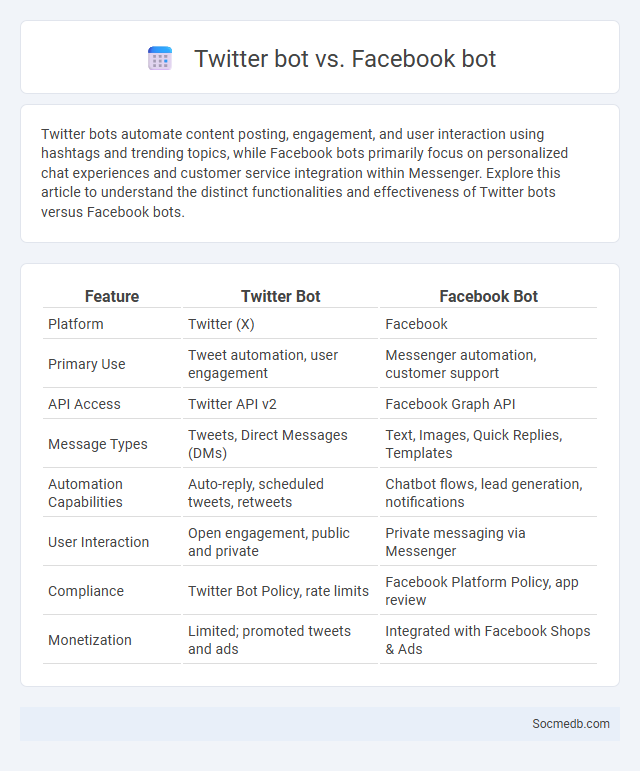
Photo illustration: Twitter Bot vs Facebook Bot
Twitter bots automate content posting, engagement, and user interaction using hashtags and trending topics, while Facebook bots primarily focus on personalized chat experiences and customer service integration within Messenger. Explore this article to understand the distinct functionalities and effectiveness of Twitter bots versus Facebook bots.
Table of Comparison
| Feature | Twitter Bot | Facebook Bot |
|---|---|---|
| Platform | Twitter (X) | |
| Primary Use | Tweet automation, user engagement | Messenger automation, customer support |
| API Access | Twitter API v2 | Facebook Graph API |
| Message Types | Tweets, Direct Messages (DMs) | Text, Images, Quick Replies, Templates |
| Automation Capabilities | Auto-reply, scheduled tweets, retweets | Chatbot flows, lead generation, notifications |
| User Interaction | Open engagement, public and private | Private messaging via Messenger |
| Compliance | Twitter Bot Policy, rate limits | Facebook Platform Policy, app review |
| Monetization | Limited; promoted tweets and ads | Integrated with Facebook Shops & Ads |
Introduction to Social Media Bots
Social media bots are automated programs designed to perform repetitive tasks on social networking platforms such as Twitter, Facebook, and Instagram. These bots can generate content, like posts, follow users, and engage in conversations to influence public opinion or increase visibility. Their use spans marketing campaigns, customer service automation, and sometimes malicious activities like spreading misinformation or manipulating trends.
What is a Twitter Bot?
A Twitter bot is an automated software application programmed to perform tasks such as tweeting, retweeting, liking, following, or direct messaging on the Twitter platform. These bots can be used for various purposes including marketing campaigns, customer service, news dissemination, or even spreading misinformation. Leveraging APIs, Twitter bots operate based on predefined rules or artificial intelligence to interact with users and gather data seamlessly.
Features and Uses of Twitter Bots
Twitter bots automate tasks such as posting tweets, liking content, and following accounts to increase engagement and reach. They analyze trends and user interactions to provide personalized content and prompt responses, enhancing social media marketing strategies. Your brand can leverage Twitter bots to streamline communication and maintain active online presence with minimal effort.
What is a Facebook Bot?
A Facebook Bot is an automated software designed to interact with users on Facebook Messenger, enabling instant communication and customer support. Your business can use these bots to answer common questions, send updates, and even process transactions, improving user engagement and efficiency. Leveraging a Facebook Bot helps streamline workflows by handling repetitive tasks without human intervention.
Features and Uses of Facebook Bots
Facebook bots enhance user engagement by automating responses and providing instant customer support through Messenger. These AI-driven chatbots streamline interactions such as booking appointments, answering FAQs, and processing orders, improving efficiency for businesses. Integration with Facebook Pages and real-time analytics enables marketers to personalize campaigns and track performance effectively.
General Overview: What is a Bot?
A bot is an automated software application designed to perform repetitive tasks on social media platforms, such as liking, commenting, or following accounts. These programs can mimic human behavior, enabling rapid content dissemination and interaction with users at scale. Bots are often used for marketing, customer service, or influencing public opinion, but they can also contribute to misinformation and spam.
Key Differences: Twitter Bots vs. Facebook Bots
Twitter bots primarily automate tweet posting, retweeting, and hashtag tracking to boost engagement and follower count rapidly, while Facebook bots focus on personalized messaging, customer support, and interactive experiences within Messenger. Your choice should depend on whether you prioritize broadcasting information broadly on Twitter or fostering direct, conversational interactions on Facebook. Understanding these key differences helps optimize your social media strategy for platform-specific objectives.
Benefits and Challenges of Social Media Bots
Social media bots offer significant benefits such as automating customer engagement, enhancing content distribution, and analyzing large volumes of user data for targeted marketing strategies. However, challenges include the potential for spreading misinformation, decreasing authentic user interaction, and the risk of account suspension due to platform policies against automated behavior. Effective management of social media bots requires balancing automation advantages with ethical considerations and compliance with platform guidelines.
Security and Ethical Considerations
Protecting Your privacy on social media requires robust security measures such as strong passwords, two-factor authentication, and regular updates to prevent unauthorized access. Ethical considerations include respecting user consent, avoiding the spread of misinformation, and ensuring data is not exploited for manipulative advertising or surveillance. Staying informed about platform policies and cyber threats helps maintain a safe and trustworthy online environment for Your digital interactions.
Choosing the Right Bot for Your Needs
Selecting the right social media bot depends on your specific goals, whether it's increasing engagement, automating posts, or managing customer interactions. Tools like Hootsuite and Buffer excel in scheduling and analytics, while ManyChat specializes in chatbot-driven customer support. Evaluating features such as AI capabilities, integration options, and scalability ensures the bot aligns with your brand's growth strategy.
 socmedb.com
socmedb.com